Joseph’s and Hyrum’s Death Masks: A Tangible Reminder of the Martyrdom
Contributed By Valerie Johnson, Church News staff writer
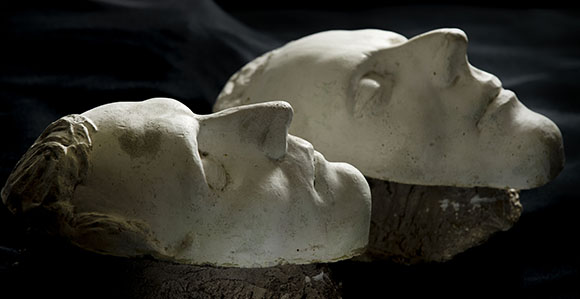
The Pedestal death masks of Hyrum and Joseph Smith are photographed at the Church History Museum in Salt Lake City on Thursday, June 13, 2019.
Article Highlights
- By making the death masks, the members showed their respect for Joseph Smith as a prophet.
- Both death masks are currently on display in the Church History Museum.
- Modern technology continues to tell us more about the time of the Smiths’ deaths, such as where the masks were made.
Related Links
In the late morning on June 28, 1844, the bodies of Joseph Smith Jr. and his brother Hyrum arrived in Nauvoo, Illinois. They were taken to George Cannon, father of subsequent leader George Q. Cannon and a furniture maker by trade who doubled as the local undertaker since he made coffins as well as cabinets. With the help of a few others, he washed the bodies and prepared them for their families to view in only a few hours.
Hyrum’s face, black with bruising, had a hole on the left side of his face from a .54-caliber bullet, and with the hot, humid June atmosphere, both bodies likely began to swell and deteriorate even as they were prepared for the death mask impressions and burial.
Joseph and Hyrum’s bodies were positioned sitting up, and a frame was built around their heads for the molds to be made of their faces. The molds took an hour or more to dry before they could be removed without distorting the features of the Prophet and his brother.
William Rowley, a plasterer by trade, would later make the positive images from the molds. But first, they needed to dry for at least a day before he could pour the casts.
The resulting masks have never been in the Smith family’s possession.
And now they are on display at the Church History Museum, where visitors from all over the world can come face to face with the Prophet Joseph and his brother Hyrum.
“This Is Our Prophet”
Making death masks had been in practice for at least several decades by the time of the martyrdom.
“Probably the best known at that time was Napoleon’s,” said Mark Staker, a curator in the Historical Sites Division of the Church History Department.
Generally death masks were made for famous or prominent individuals. So making these death masks “suggested an attitude toward Joseph and Hyrum: This is an important man. This is our prophet. We want to remember them.”
In addition to the masks of Joseph and Hyrum, the Church History Museum owns the death mask of at least one other prominent Church leader: Brigham Young.
“His death mask and his hands were cast, and all of his hair was shaved off before he was buried, and it’s still in our collections,” Staker said. “It’s never been exhibited. I think people would be interested in seeing that one day, because there’s Brigham.”
Many death masks have not survived over the centuries. In humid environments, the plaster doesn’t last long. However, Utah provides a better climate for the survival of the death masks in the Church’s collection. “We’re in a very dry environment, and so it’s fairly easy to keep them preserved,” Staker explained.
How to Make a Death Mask
Sam Weston, a docent at the Church History Museum, has been independently researching the martyrdom of Joseph and Hyrum Smith for the last 10 years. In his efforts to have a hands-on approach to experiencing Church history, Weston practices making death masks on copies of the ones in the museum. The methods he uses include modern techniques as well as ones that would have been used in 1844.
He’s also found that making death masks requires a level of skill to get right. “It’s not something you learned right away,” he said.
The molds take time to dry enough to the point that they won’t be distorted when pulled off of the faces, he said, and “it takes almost 24 hours, from my experience, for them to be dry enough to where you’d want to pour another liquid into them.”
The molds can be used only once, Weston explained. “You make the mold, you pour it, and the mold’s pretty well destroyed getting the death mask out. Some people say, ‘Maybe they made multiple molds that day.’ But I don’t think they had time, to be honest.”
One feature that appears on Hyrum’s mask is a distortion or bump on the left side of his face, next to his nose, where he was shot. “The assumption is that there’s a cotton ball or something in there that created that protrusion out . . . that they’d filled the hole with cotton to make the death mask,” Staker explained. “It probably was more of a little rag or something, but they did fill in that hole so there is a feature there that came from where he was shot.”
Masks on Display
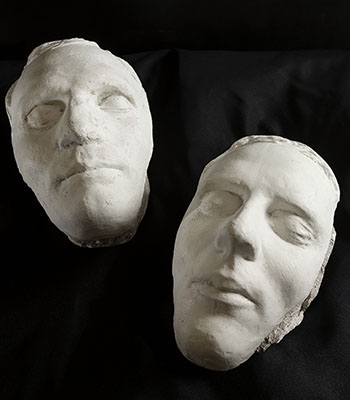
The Pedestal death masks of Hyrum and Joseph Smith are photographed at the Church History Museum in Salt Lake City on Thursday, June 13, 2019. Photo by Laura Seitz, Deseret News.
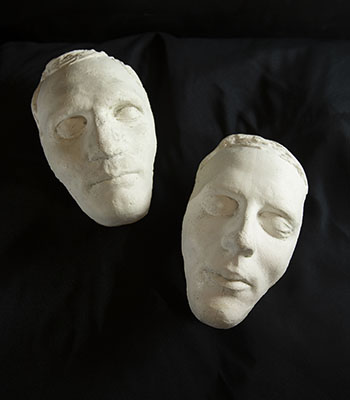
The Pedestal death masks of Hyrum and Joseph Smith are photographed at the Church History Museum in Salt Lake City on Thursday, June 13, 2019. Photo by Laura Seitz, Deseret News.
It’s believed that the masks were in George Cannon’s possession until his death in 1844. At that point, William Rowley obtained them.
Rowley then sold the masks to Philo Dibble, a close friend to Joseph Smith, in 1849 for $100—a half a year’s salary for a laborer—in Winter Quarters, according to Staker.
“He exhibited them throughout the Utah Territory for decades,” he said. “Then as people kind of felt like, ‘Oh yeah, seen that. Old stuff,’ he sold them to an artist, James [Henry] Brown.”
Brown’s family then sold the masks to Wilford C. Wood, a furrier who dedicated much of his life to buying and preserving historical Church artifacts and lands as he traveled the country. The masks were displayed in his personal museum in Bountiful, Utah, for several decades.
After Wood’s death, pieces of his collection were donated to the Church by his daughters, Glade and Mary W. Cannon. In 1990, they donated uncut sheets of an original 1830 copy of the Book of Mormon as well as the death masks to the Church History Department.
On May 19, 1990, the death masks were put on permanent display in the Museum of Church History and Art (since renamed as the Church History Museum).
Currently, they’re on display in the “The Heavens Are Opened” exhibit, which opened on September 29, 2015. Except for short periods of time when they’ve moved from one exhibit to another, the masks have been on display since 1990.
A Second Set of Death Masks
The Church History Museum has two sets of Joseph and Hyrum Smith death masks in its collection. The one on display is known as the Dibble set, named after Philo Dibble, which the Cannon family donated to the Museum.
The second is known as the Pedestal masks due to the pedestals on the back of each of them.
Where or how the Pedestal masks originated is unclear. Staker has been researching their origin but can’t say for certain when or how they were made.
“It looks like they probably varnished the first [death masks] so it would give it a good release, and then they made another mold from the first to make the second,” he told the Church News.
John Taylor, third President of the Church, who was present at Carthage Jail during the martyrdom, owned the Pedestal masks, which he took to an artist in England along with some sketches of Joseph and Hyrum, Staker said. “John Taylor got together a little committee of people who had known Joseph personally, and they had [the artist] make these busts of Joseph and Hyrum from the death masks.”
Those busts were sold to members of the Church but were easily broken. According to Staker, only one bust of Joseph and Hyrum each are known to survive today: one of Joseph is in the Church History Museum’s collection, and one of Hyrum is owned by the Daughters of the Utah Pioneers.
The Pedestal masks provide some detail that the Dibble masks lack.
According to Staker, the museum conservator did some restoration work on Joseph’s hair and Hyrum’s chin, leaving the repaired portions a stark white plaster. “He did that without knowing the Pedestal busts existed,” Staker said. “And so the Pedestal busts actually have better information because they have details that were lost and damaged over time on those death masks.”
If one compares the Pedestal masks to the Dibble masks, Weston said, he or she will find that “Hyrum’s chin is a little smaller than the Dibble masks. He also has a cleft chin, which is a detail we don’t get on the Dibble masks.”
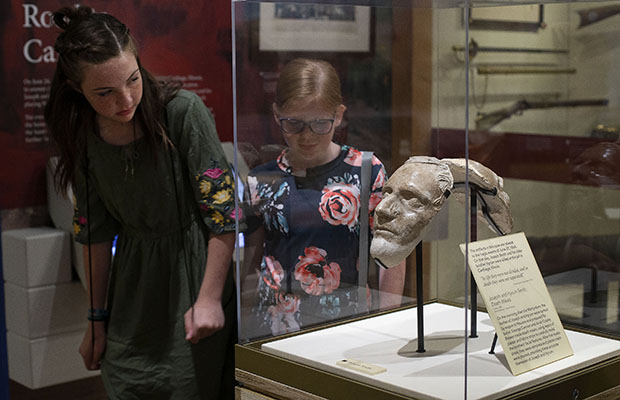
Brielle Fawson, 14, and Savannah Carter, 12, of Grantsville look at the Dibble death masks of Hyrum and Joseph Smith at the Church History Museum in Salt Lake City on Thursday, June 13, 2019. Photo by Laura Seitz, Deseret News.
Depicting the Prophet
Many artists have referred to the death masks to more accurately portray Joseph and Hyrum Smith in sculptures and paintings. This might not be entirely accurate, however.
The masks do reflect what Joseph and Hyrum looked like, Weston said, “but they look like the day after they died.”
Having visited Carthage once, on June 27, he reported it was 104 degrees Fahrenheit with 99 percent humidity. “The distortion of these bodies in that 24-hour period should be considered, especially since they died violently. So they’re probably a close representation, but I hate to say this is what Hyrum and Joseph looked like.”
Staker noted that later in life, John Taylor mentioned in a letter that the death masks didn’t look like Joseph and Hyrum Smith. “He seemed to think they were helpful earlier, because he took them to England,” Staker added, but it’s a reminder that the masks reflect changes to their bodies after they died.
“Until we find a photograph, if there is ever one—evidence suggests that most likely there never was a photograph of [Joseph] taken—we’ll never know exactly what he looked like.”
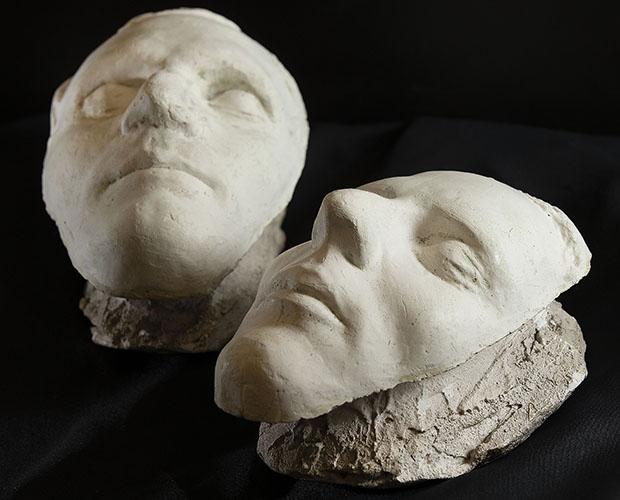
The Pedestal death masks of Hyrum and Joseph Smith are photographed at the Church History Museum in Salt Lake City on Thursday, June 13, 2019. Photo by Laura Seitz, Deseret News.
21st-Century Technology
While some details about the death masks may never become clear over time, modern technology can reveal a few more secrets.
For instance, Weston isn’t sure that the casts were poured in Nauvoo in 1844. Due to the ambiguity of historical documents, the Dibble masks could have been poured anytime between 1844 and 1849.
“We’re going to hopefully do some testing here this summer in conjunction with the museum in determining the composition of the Dibble masks and the Pedestal masks,” Weston said. By scanning the masks, they might be able to determine the makeup of the plaster and identify whether the material came from a Nauvoo area or not.
“That might help us pin down exactly when they were made.”
But the death masks have already helped settle one question concerning Joseph and Hyrum Smith’s bodies.
In 1928, the Reorganized Church of Jesus Christ of Latter-day Saints (now known as the Community of Christ) had the bodies of Joseph, Hyrum, and Emma Smith relocated before the rising Mississippi River could submerge their graves. When the skeletal remains were exhumed, they were carefully photographed and measured before they were reinterred.
However, controversy began to arise in the 1990s when claims were made that Joseph and Hyrum’s bodies had been misidentified and placed in the wrong graves.
In a 2013 paper published by the independently owned Mormon Historical Studies organization, Curtis G. Weber explained how he used the death masks of Joseph and Hyrum Smith, the photographs of their skulls from 1928, Joseph Smith’s 1840 phrenology measurements, and established anatomical principles to determine tissue depth to conclusively identify each brother’s remains.
Joseph and Hyrum Smith are in the correct graves, according to Weber’s conclusions.
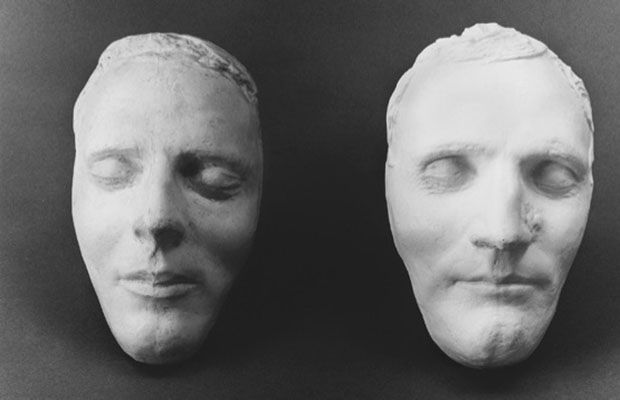
The Dibble death masks of Joseph Smith Jr., left, and Hyrum Smith, right. Photo courtesy of the Church History Library.
Sacred Items
Seeing the death masks in person can have a profound impact on the viewer, Staker said, including for scholars who are not members of the Church.
“One of them I can recall saying, ‘Wow, that’s like looking at the true cross of Jesus Christ,’” he said.
Looking at the plaster that the Dibble masks are made from, Staker believes the materials likely came from the same quarry the Nauvoo Temple was being built from. “They were working on the temple right then, so it’s probably a ground-up limestone from the temple that they then used to make the death masks,” he said.
These objects that provide physical reminders of the life and death of Joseph and Hyrum Smith have been and continue to be treated with care. Because of the preservation of these items, visitors to the Church History Museum can come face to face with these artifacts from the martyrdom.
—Alan Morrell, artifacts curator at the Church History Museum, assisted with the research for this article.
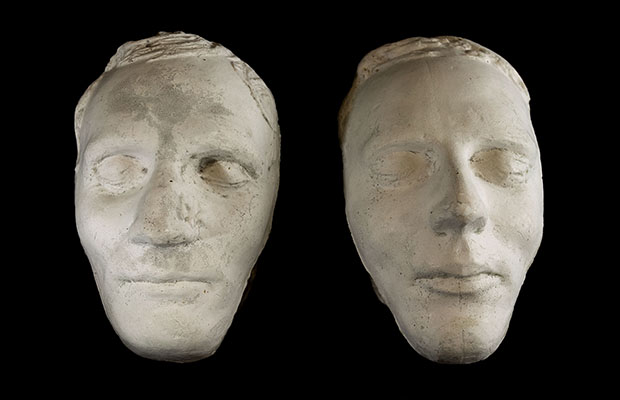
The Pedestal death masks of Hyrum and Joseph Smith are photographed at the Church History Museum in Salt Lake City on Thursday, June 13, 2019. Photo by Laura Seitz, Deseret News.
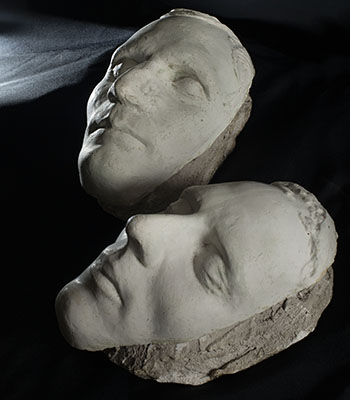
The Pedestal death masks of Hyrum and Joseph Smith are photographed at the Church History Museum in Salt Lake City on Thursday, June 13, 2019. Photo by Laura Seitz, Deseret News.
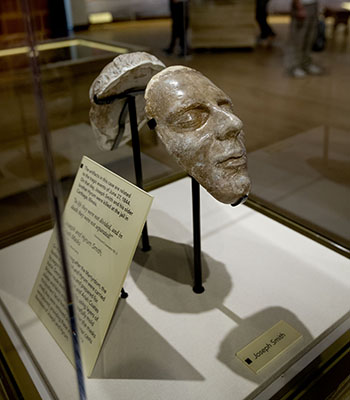
The Dibble death masks of Joseph and Hyrum Smith are displayed at the Church History Museum in Salt Lake City on Thursday, June 13, 2019. Photo by Laura Seitz, Deseret News.
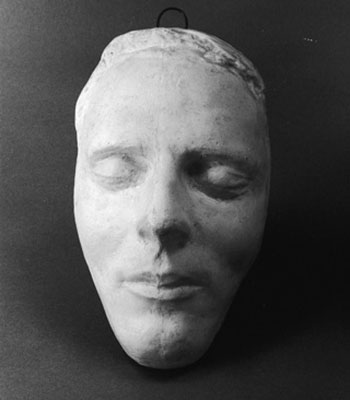
The Dibble death mask of Joseph Smith Jr.
Photo courtesy of the Church History Library.
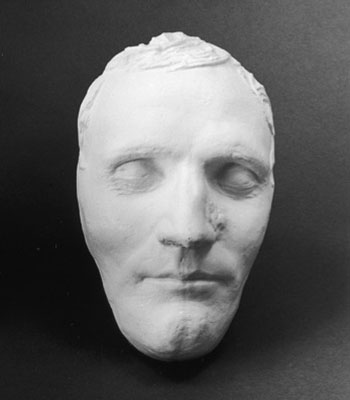
The Dibble death mask of Hyrum Smith. Photo courtesy of the Church History Library.
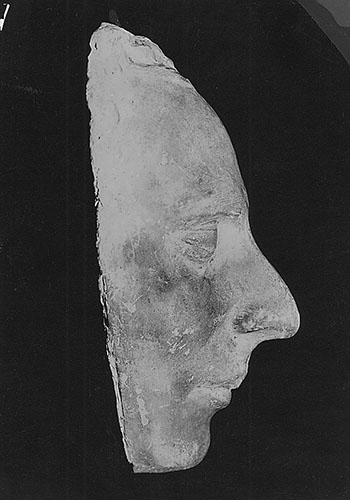
A side view of the Dibble death mask of Joseph Smith Jr. Photo courtesy of the Church History Library.
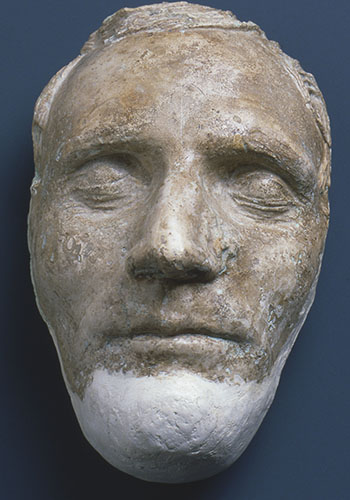
The Dibble death mask of Hyrum Smith. The mask’s chin was broken and restored in 1980. Photo courtesy of the Church History Library.
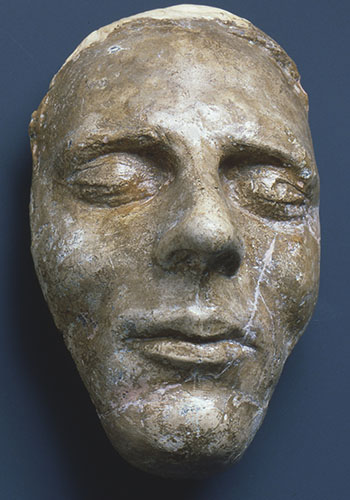
The Dibble death mask of Joseph Smith Jr. Photo courtesy of the Church History Library.
